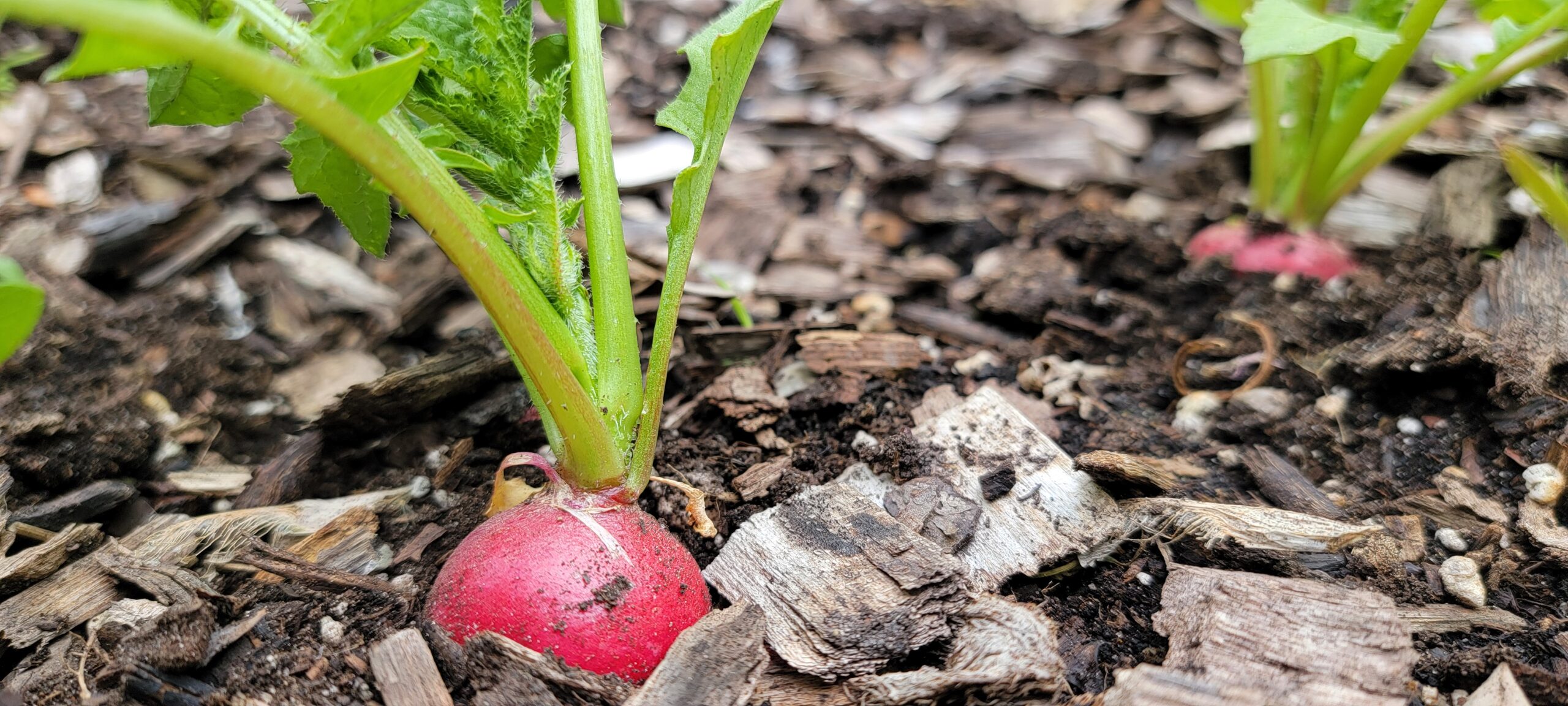Radish Donation Tracker
Quick Links: How & Where to Grow | Temperature | How to Care For | Harvest Signs | Harvesting | Pests | Companions | Flavor | Preservation | Recipes | Michigan Tips | Fun Facts
🌱 How & Where to Grow Radishes:
- Direct sow seeds ½-1 inch deep when soil reaches 40°F.
- Space seeds 1 inch apart in rows 6-12 inches apart.
- Succession plant every 10 days for continuous harvest – they’re the ultimate fast crop!
- Sunlight: Full sun (6-8 hours) preferred, tolerates partial shade.
- Soil Type: Radishes prefer loose, well-drained soil with a pH of 6.0 to 7.0.
- Soil Amendment: Work in compost for nutrients, but avoid fresh manure which causes forked roots
Radishes are perfect for impatient gardeners – some varieties are ready in just 20 days!
🌡️ Temperature Guidance:
Spring: 40°F soil minimum. Fall: Plant August-September. Avoid summer heat.
- Optimal growing: 55-65°F for best quality and mild flavor.
- Germination: Seeds sprout in 3-10 days depending on temperature.
- Radishes bolt quickly in temperatures above 85°F, becoming pithy and overly pungent.
- They can tolerate light frosts, making them perfect for early spring and late fall.
Michigan’s cool springs and falls are ideal – skip summer planting unless you have consistent shade!
💧 How to Care for:
- Consistent Moisture: Keep soil evenly moist but not waterlogged.
- Watering: Provide 1 inch of water weekly – inconsistent watering causes cracking.
- Mulch: Light mulch helps retain moisture and keep roots cool.
- Fertilizer: Usually unnecessary in amended soil – too much nitrogen produces leaves over roots.
- Thinning: Thin to 2-inch spacing when seedlings are 1 inch tall for proper root development.
📏 Harvest Signs:
3-5 weeks from planting. Size varies by variety. Harvest promptly.
- Check maturity by gently brushing soil away from the shoulder.
- Spring radishes are typically ready at 1 inch diameter.
- Winter radishes (like daikon) can grow much larger and take 60+ days.
- Shoulders will push slightly above soil when ready.
Don’t delay harvest – radishes quickly become woody and hollow if left too long!
🧺 Harvesting:
Pull when soil moist. Remove greens immediately.
- Always harvest in the morning for crispest texture.
- Test one first – pull a sample to check size and quality.
- Gently pull straight up – radishes usually come out easily.
- Cut greens immediately to prevent moisture loss from roots.
- Don’t discard greens – they’re edible and nutritious!
🪲 Michigan Pests:
Flea beetles (major pest – use row covers), cabbage maggots, wireworms.
- Flea beetles create tiny holes in leaves – floating row covers are essential protection.
- Cabbage maggots tunnel into roots – rotate crops and avoid planting after brassicas.
- Wireworms bore holes through radishes – till soil in fall to expose them to predators.
- Quick growth helps radishes outpace many pest problems.
🫱🏽🫲🏼 Companions:
Excellent with lettuce, carrots, beets. Natural row markers for slow crops.
- Radishes mark rows of slow-germinating carrots and parsnips.
- Interplant with lettuce – radishes will be harvested before lettuce needs the space.
- Great pest deterrent for cucumber beetles when planted near cucumbers.
- Avoid planting near hyssop or other brassicas.
- Use as trap crop for flea beetles to protect other plants.
🍴 Flavor:
Crisp, peppery. Cool weather = milder flavor.
- Spring radishes grown in cool weather are mild and sweet.
- Heat-stressed radishes become extremely hot and pungent.
- Different varieties range from mild ‘Cherry Belle’ to spicy ‘Black Spanish’.
- French breakfast radishes have mild tips and spicier shoulders.
- Asian varieties like daikon are generally milder with sweet undertones.
🫙 Preservation:
Fresh (1-2 weeks), pickled, fermented, dehydrated chips.
- Store fresh radishes in perforated plastic bags in the crisper drawer.
- Remove greens before storage but save for cooking.
- Quick-pickle sliced radishes with rice vinegar for pink pickles.
- Ferment whole small radishes like traditional Korean kkakdugi.
- Dehydrate thin slices for crunchy radish chips.
- Freeze only if you plan to cook them – texture changes significantly.
🧑🏽🍳 Recipes:
Fresh salads, roasted radishes, radish green pesto, kimchi.
- Try radishes with butter and sea salt – a classic French appetizer!
- Roast whole radishes with olive oil at 425°F until golden and sweet.
- Make radish green pesto with garlic, nuts, and parmesan.
- Quick-pickle with ginger and chilies for banh mi sandwiches.
- Shave paper-thin for elegant salads and garnishes.
✋🏼 Michigan Tips:
- Perfect for early spring.
- Fall radishes sweeter.
- Great for kids’ gardens.
- Start planting as soon as soil can be worked in March/April.
- Use row covers for earliest plantings to protect from flea beetles.
- Plant fall crop in shady areas to extend the season.
- Mix varieties for different colors, shapes, and harvest times.
🧠 Fun Facts:
- 5-year seed shelf life.
- Leaves have more vitamin C than roots!
- Ancient Egyptians ate radishes before building the pyramids for stamina.
- The world’s heaviest radish weighed 68 pounds 9 ounces, grown in Japan.
- Radishes were one of the first European crops grown in the Americas.
- They’re actually related to cabbage and turnips, not carrots.
- Greeks made gold radish replicas as offerings to Apollo.
- Michigan’s quick spring and fall seasons are perfect for growing dozens of radish varieties!


0 Comments